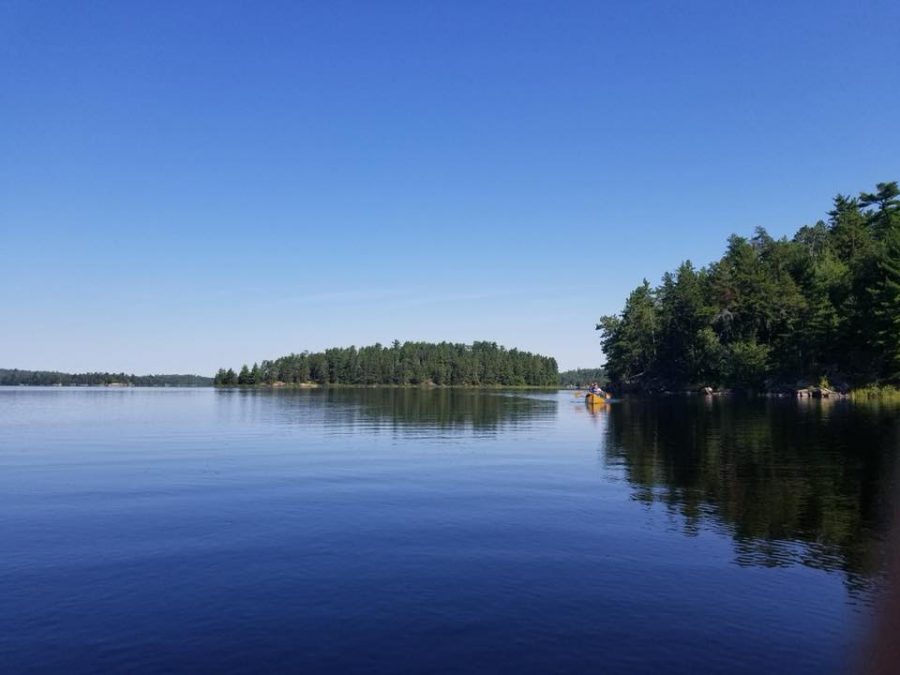Students fight for permanent protection of the Boundary Waters
Photo courtesy of Joseph Goldstein
Kids for the Boundary Waters, started by 17 year old Joseph Goldstein, fights to protect the BWCA and activate young voices. Goldstein has been traveling to the Boundary Waters since he was six and remembers that, “Paddling into the BWCA felt like coming home.”
October 15, 2018
The Boundary Waters Canoe Area (BWCA) is in danger of toxic mining practices after the Trump administration cancelled a stay on mineral leasing in it’s watershed. The stay was put in place to stop mines from being developed in the area. It was supposed to last for two years while an environmental review was underway to determine if the proposed sulfide-ore copper mine would damage or benefit the area.
There will be a group of 31 high school students from across the United States attending a trip to D.C. to lobby politicians about creating permanent protection for the BWCA this November. One of their focuses will now be on sharing their thoughts on the importance of a continued environmental review, that will determine the effects of sulfide-ore mining on the area. The trip is being organized by a student run organization; Kids for the Boundary Waters.
“There’s so much value in having an area people can go to just collect their thoughts,” said South High junior Isaiah Bischoff, who will be attending the D.C. trip this fall.
Kids for the Boundary Waters, was started by 17 year old Joseph Goldstein in an effort to protect the BWCA and activate young voices. Goldstein has been traveling to the Boundary Waters since he was six and remembers that, “Paddling into the BWCA felt like coming home.”
Goldstein and the group will be arranging meetings with many different politicians to voice their concerns about issues involving the future of the BWCA. “We really won’t know who we’ll be able to get meetings with until the week before or even day of,” said Goldstein.
During the trip students will be learning about both the environmental challenges at hand and how to advocate for things they care about. Bischoff said, “A personal goal would be to just find my voice a little more and I know that’s gonna be one of the thing’s we’ll be working on on the trip.” Bischoff also said, “I would like to show legislators and people who have power on these issues that young people care about the area.”
Greta Lahm, South senior who will also be on this November’s trip said, for her one, of the most important things to think about going into the trip is, “knowing that change is not going to come right away, and knowing that what we’re doing has an impact. And after the trip further steps can be taken and we can continue to advocate for the BW.”
Many people across the country have a want to protect the BWCA. The initial mineral leasing stay went into action towards the end of the Obama Administration, in 2016. “The Forest Service segregated approximately 234,000 acres from the federal mineral estate,” according to the USDA. The land is a part of the Rainy River watershed that feeds directly into the BWCA.
The most imminent threat to maintaining the environmental sanctity of the area is sulfide-ore copper mining. This type of mining creates waste that leaches sulfuric acid, sulfates and heavy metals. These pollutants enter nearby water sources and would spread across the watershed.
Sulfide-ore copper mining has been reported as “America’s most polluting industry,” by the EPA.
If the land does become available for mineral leasing, Twin Metals Minnesota, will be quick to start the process of opening a sulfide-ore copper mine in the watershed.
The company is part of a larger Chilean copper mining group, Antofagasta. They have been trying to get access to Northeastern Minnesota resources for years.
When the environmental review was first put into action, Twin Metals Minnesota stated, “The [federal] actions will have a devastating impact on the future economy of the Iron Range and all of northeast Minnesota, eliminating the promise of thousands of good-paying jobs and billions of dollars of investment in the region.”
The goal of utilizing the BWCA and surrounding areas to create the most economic growth is a key factor in the debate of whether cancelling the review or continuing it will have the most benefit.
Sonny Perdue, director of the USDA stated, “It’s our duty as responsible stewards of our environment to maintain and protect our natural resources. At the same time, we must put our national forests to work for the taxpayers to support local economies and create jobs,” following the announcement of the cancellation of the mineral leasing stay.
Perdue’s statement places the short term economic gain from the mining industry, over the growing recreation based economy. After the announcement a study was released comparing the expected benefits of both industries. The study showed that the benefits of the mine may not be as great as Perdue has stated.
Harvard Professor James H. Stock, concluded, “If mining is commenced at [Twin Metals Minnesota], there would likely be an initial but temporary net growth in employment and income associated with the mining activity. Over time, the economic benefits of mining would be outweighed by the negative impact of mining on the recreational industry and on in-migration,” after analyzing economic growth patterns.
The guaranteed pollution of sulfide-ore mining would damage the already growing recreational economy. This outcome brings more attention towards the positive economical effects of preserving the BWCA and surrounding areas.
Although the future of the Boundary Waters is still undetermined, South students will do what they can to advocate for its permanent preservation and protection. Through the process of reaching for their goals, students hope to build lifelong skills of making change and creating a better environment for future generations.







Kemia Sarraf • Oct 16, 2018 at 11:43 am
Wonderful article – well researched, very well-written. Proud of ALL these young people for the work they’re doing on behalf of the BWCA.